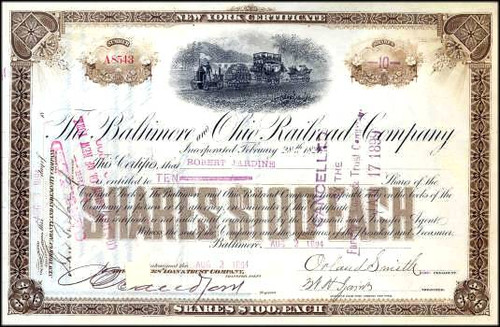Beautifully engraved certificate from the Cincinnati, Washington and Baltimore Railroad Company issued no later than 1887. This historic document was printed by the American Bank Note Company and has an ornate border around it with a vignette of a train passing in front of a small building. This item is hand signed by the Company's President and Secretary and is over 120 years old. 
Certificate Vignette Orland Smith (May 2, 1825 October 3, 1903) was a railroad executive and a brigade commander in the Union Army during the American Civil War. He led a spirited bayonet charge during the Battle of Wauhatchie that took a significant Confederate position on a hill that now bears his name. Smith was born in New England in Lewiston, Maine. He was educated in the local schools and became a railroad agent, serving as station manager at Lewiston until 1852 when he moved to Ohio. He became an official of the Marietta and Cincinnati Railroad and settled in Chillicothe, Ohio. He was a commander of a militia company in the late 1850s, the "Chillicothe Greys." With the outbreak of the Civil War, Smith joined the Union army and became the Colonel of the 73rd Ohio Volunteer Infantry, raised in Chillicothe, and trained at nearby Camp Logan. Among his volunteer soldiers was Pvt. George Nixon III, the great-grandfather of future President Nixon. The regiment saw action as a part of the Army of Virginia during the Second Battle of Bull Run, after previously serving in western Virginia and fighting at the Battle of McDowell and the Battle of Cross Keys. Smith assumed brigade command in the XI Corps in October 1862, but he did not participate in the Battle of Chancellorsville. He returned to his command shortly before the Gettysburg Campaign. His men held Cemetery Hill on the first day of the Battle of Gettysburg at the orders of Maj. Gen. Oliver O. Howard, and provided an anchor for the retreating Federal soldiers. On the second day, they helped repulse an attack by Brig. Gen. Harry T. Hays' "Louisiana Tigers". Sent to the Western Theater in the autumn of 1863 along with the XI Corps, Smith fought at the Battle of Chickamauga. During the Chattanooga Campaign, Smith led his brigade in the Army of the Cumberland in a successful bayonet assault up a steep hill that now bears his name (Smith's Hill) during the Battle of Wauhatchie. In the army reorganization later that year, his brigade was disbanded and he returned to the command of the 73rd OVI. He was breveted as a brigadier general on March 13, 1865. After the war, he returned to his career as a railroad officer and became President of the Cincinnati, Washington and Baltimore Railroad and later, First Vice President of the Baltimore and Ohio Railroad, with his office in Baltimore, Maryland. Smith died in Chicago, Illinois. He is buried in Green Lawn Cemetery, Columbus, Ohio. The Scioto and Hocking Valley came under control of the Marietta & Cincinnati Railroad, which the B&O acquired in 1882 and changed the name of the company to the Cincinnati, Washington & Baltimore Railroad. In December 1889, this company ultimately became the B&O Southwestern Railroad, which portions of are still in existence as the Great Miami & Scioto Railroad and CSX Transportation.

Certificate Vignette








